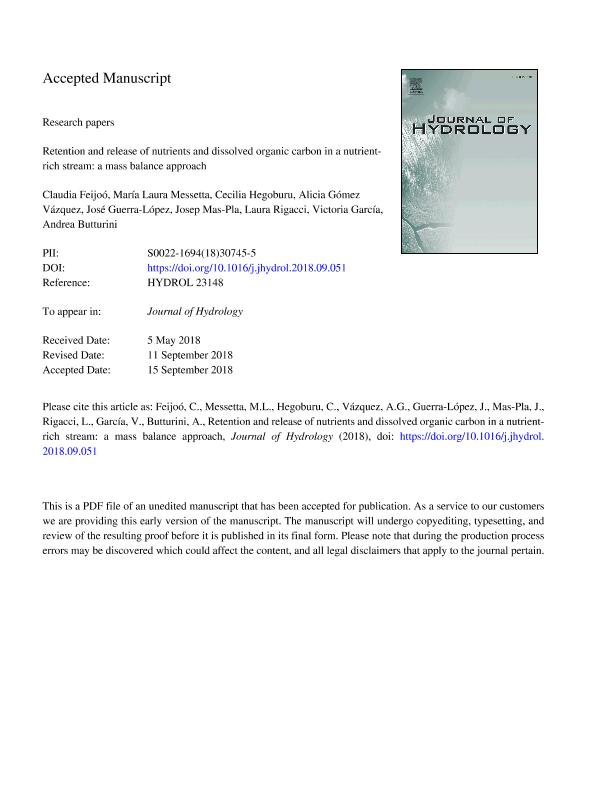Artículo
Retention and release of nutrients and dissolved organic carbon in a nutrient-rich stream: A mass balance approach
Feijoó, Claudia Silvina; Messetta, María Laura ; Hegoburu, Cecilia
; Hegoburu, Cecilia ; Gómez Vázquez, Alicia; Guerra López, José Rodolfo; Mas Pla, Josep; Rigacci, Laura Natalia
; Gómez Vázquez, Alicia; Guerra López, José Rodolfo; Mas Pla, Josep; Rigacci, Laura Natalia ; García, Victoria Julieta
; García, Victoria Julieta ; Butturini, Andrea
; Butturini, Andrea
 ; Hegoburu, Cecilia
; Hegoburu, Cecilia ; Gómez Vázquez, Alicia; Guerra López, José Rodolfo; Mas Pla, Josep; Rigacci, Laura Natalia
; Gómez Vázquez, Alicia; Guerra López, José Rodolfo; Mas Pla, Josep; Rigacci, Laura Natalia ; García, Victoria Julieta
; García, Victoria Julieta ; Butturini, Andrea
; Butturini, Andrea
Fecha de publicación:
11/2018
Editorial:
Elsevier Science
Revista:
Journal Of Hydrology
ISSN:
0022-1694
Idioma:
Inglés
Tipo de recurso:
Artículo publicado
Clasificación temática:
Resumen
The relevance of fluvial systems to process nutrients and carbon is widely accepted, but their role as sinks and sources of nutrients and dissolved organic carbon (DOC) is still under discussion especially in non-forested and highly productive streams. In this study, we used a mass balance approach at a reach scale in a Pampean stream to elucidate the major sources of water, nutrients and DOC as well as to determine net in-stream retention efficiencies of nutrients and DOC under different hydrological conditions. We measured conductivity, conservative ions (chloride and calcium), soluble reactive phosphorus (SRP), nitrate (NO3), nitrite (NO2), ammonium (NH4) and DOC at the end-point of a reach of Las Flores stream (site A), at two upstream tributaries (B1 and B2), and at each potential hydrological contributors to stream flow (groundwater, overland and subsurface flows, and rainfall). In addition, we monitored one storm event where we collected samples during the rising and the recession limb of the hydrograph. Stream flow originated from groundwater (≈50%), upstream tributaries (B1 and B2) at baseflow, whereas overland flow contributed >20% during high flows. During baseflow, groundwater provided NO3 to stream water, while B2, which received a point input of a dairy industry, was the main source of SRP and NH4. Conversely, SRP and NH4 were provided by B1, overland flow and subsurface flow during high flows. Overland flow also contributed DOC during high flow periods. Mass balance estimates revealed that the reach acts as a source of DOC, SRP and NO3 (21.4, 37.4 and 53.5% mean net in-stream release, respectively) and a sink of NH4 (−36.8% mean net in-stream retention). Relevant in-stream processes may be nutrient uptake (as in the case of SRP and NH4) and biotic production (DOC), as well as decomposition (SRP) and nitrification (NH4) in this Pampean stream. Our results stress the relevance of nutrient and DOC generation processes within the channel in non-forested and highly productive streams.
Palabras clave:
GROUNDWATER
,
IN-STREAM PROCESSING
,
NITROGEN
,
PHOSPHORUS
,
STORM EVENTS
Archivos asociados
Licencia
Identificadores
Colecciones
Articulos(CADIC)
Articulos de CENTRO AUSTRAL DE INVESTIGACIONES CIENTIFICAS
Articulos de CENTRO AUSTRAL DE INVESTIGACIONES CIENTIFICAS
Articulos(INEDES)
Articulos de INSTITUTO DE ECOLOGIA Y DESARROLLO SUSTENTABLE
Articulos de INSTITUTO DE ECOLOGIA Y DESARROLLO SUSTENTABLE
Citación
Feijoó, Claudia Silvina; Messetta, María Laura; Hegoburu, Cecilia; Gómez Vázquez, Alicia; Guerra López, José Rodolfo; et al.; Retention and release of nutrients and dissolved organic carbon in a nutrient-rich stream: A mass balance approach; Elsevier Science; Journal Of Hydrology; 566; 11-2018; 795-806
Compartir
Altmétricas



